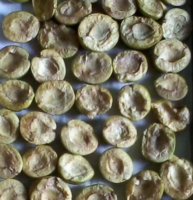Britesea
Sustainability Master
Ok, I never got around to taking pictures this weekend, but I'm going to start this thread anyway.
The first thing I'll do is describe how freeze-drying works. The food gets taken down to a super cold environment in a vacuum. Then the chamber warms up a bit. Since water cannot be liquid in a vacuum, it sublimates into a gas and leaves the food. When the sensors read that nearly all the water has left the food, it goes into a final drying period and then voila! you have a freeze-dried product.
For anyone interested in getting a freeze-dryer, I have to tell you there's a fair amount of maintenance that goes with it. The oil in the vacuum pump needs to be changed regularly since water vapor and food bits end up getting into the pump. Occasionally it needs to be power-flushed, and I read that you also occasionally have to take it apart and clean off some part that can get gunky even with all the oil changing and such. So if you want something you just run and then forget about it, maybe a freeze-dryer is not for you.
It can only handle about 10 lbs of food at a time, and depending on what it is and what the ambient temperature is, it can take anywhere from 24 to 48 hours to freeze dry things. You cannot freeze-dry high fat things like butter (you just end up with butter all over the inside of your freeze-dryer) or high sugar, like jam (the sugar binds with the water so it doesn't go away).
BUT... it's the best form of preservation there is currently, for preserving the nutrition of your food. The texture is basically the same as previously frozen. And when it's been properly protected from light and air, freeze-dried food should last 20 years or more. It weighs next to nothing compared to fresh food; and if you store it in mylar or sealed plastic bags, you don't have to worry about a big mess if there's an earthquake.
Currently I have a load of golden plums in there. I'll take pictures and give you a review on their taste and texture tomorrow.
The first thing I'll do is describe how freeze-drying works. The food gets taken down to a super cold environment in a vacuum. Then the chamber warms up a bit. Since water cannot be liquid in a vacuum, it sublimates into a gas and leaves the food. When the sensors read that nearly all the water has left the food, it goes into a final drying period and then voila! you have a freeze-dried product.
For anyone interested in getting a freeze-dryer, I have to tell you there's a fair amount of maintenance that goes with it. The oil in the vacuum pump needs to be changed regularly since water vapor and food bits end up getting into the pump. Occasionally it needs to be power-flushed, and I read that you also occasionally have to take it apart and clean off some part that can get gunky even with all the oil changing and such. So if you want something you just run and then forget about it, maybe a freeze-dryer is not for you.
It can only handle about 10 lbs of food at a time, and depending on what it is and what the ambient temperature is, it can take anywhere from 24 to 48 hours to freeze dry things. You cannot freeze-dry high fat things like butter (you just end up with butter all over the inside of your freeze-dryer) or high sugar, like jam (the sugar binds with the water so it doesn't go away).
BUT... it's the best form of preservation there is currently, for preserving the nutrition of your food. The texture is basically the same as previously frozen. And when it's been properly protected from light and air, freeze-dried food should last 20 years or more. It weighs next to nothing compared to fresh food; and if you store it in mylar or sealed plastic bags, you don't have to worry about a big mess if there's an earthquake.
Currently I have a load of golden plums in there. I'll take pictures and give you a review on their taste and texture tomorrow.

